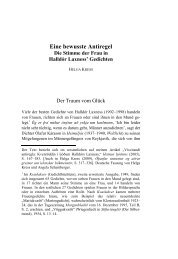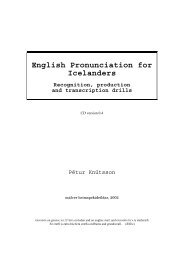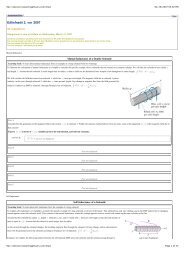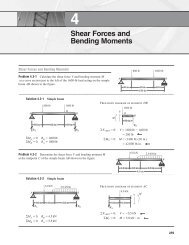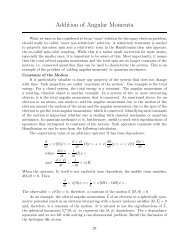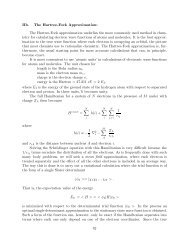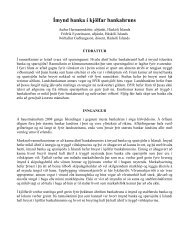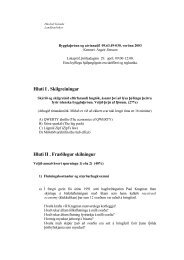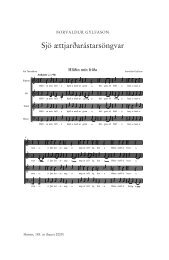Eðlisfræði 2, vor 2007
Eðlisfræði 2, vor 2007
Eðlisfræði 2, vor 2007
Create successful ePaper yourself
Turn your PDF publications into a flip-book with our unique Google optimized e-Paper software.
http://session.masteringphysics.com/myct<br />
04/19/<strong>2007</strong> 05:02 PM<br />
.<br />
The "direction of the EMF" is determined with respect to the direction of positive current flow, and represents the direction of the<br />
induced electric field in the inductor. This is also the direction in which the "back-current" that the inductor tries to generate will flow.<br />
Part A<br />
Suppose that the current in the solenoid is . Within the solenoid, but far from its ends, what is the magnetic field due to this current?<br />
Express your answer in terms of , quantities given in the introduction, and relevant constants (such as ).<br />
ANSWER: =<br />
Note that this field is independent of the radial position (the distance from the axis of symmetry) as long as it is measured at a point well inside the solenoid.<br />
Part B<br />
What is the magnetic flux<br />
through a single turn of the solenoid?<br />
Express your answer in terms of the magnetic field<br />
, quantities given in the introduction, and any needed constants.<br />
ANSWER: =<br />
Part C<br />
Suppose that the current varies with time, so that . Find the electromotive force induced across the entire solenoid due to the change in current through the entire solenoid.<br />
Part C.1 Find the flux in terms of the current<br />
In Part B you found the flux through a single turn of the solenoid. Now find the flux through the entire solenoid.<br />
Express your answer in terms of , other quantities given in the introduction, and various constants such as .<br />
ANSWER: =<br />
Part C.2<br />
Find the EMF for the entire solenoid<br />
You now have an expression for the magnetic flux that passes through the solenoid. From this, you should be able to derive an expression for the EMF in the solenoid. Suppose the total<br />
magnetic flux through the solenoid is . What is the electromotive force generated in the solenoid by the changing flux ?<br />
Express your answer in terms of<br />
and its derivative, and other variables given in the introduction.<br />
ANSWER:<br />
=<br />
Hint C.3<br />
Putting it together<br />
You have now worked out three things:<br />
1.<br />
the magnetic field from ;<br />
2.<br />
the flux from this field;<br />
3.<br />
the EMF for the entire solenoid.<br />
Put them together and you have the answer!<br />
Express your answer in terms of , , , and .<br />
ANSWER: =<br />
Part D<br />
The self-inductance is related to the self-induced EMF by the equation . Find for a long solenoid. (Hint: The self-inductance will always be a positive<br />
quantity.)<br />
Express the self-inductance in terms of the number of turns per length , the physical dimensions and , and relevant constants.<br />
ANSWER: =<br />
This definition of the inductance is identical to another definition you may have encountered: , where is the magnetic flux due to a current in the inductor. To see the<br />
correspondence you should differentiate both sides of this equation with respect to time and use Faraday's law, i.e., .<br />
Now consider an inductor as a circuit element. Since we are now treating the inductor as a circuit element, we must discuss the voltage across it, not the EMF inside it. The important point is that<br />
the inductor is assumed to have no resistance. This means that the net electric field inside it must be zero when it is connected in a circuit. Otherwise, the current in it will become infinite. This<br />
means that the induced electric field deposits charges on and around the inductor in such a way as to produce a nearly equal and opposite electric field such that !<br />
http://session.masteringphysics.com/myct<br />
Page 2 of 15



